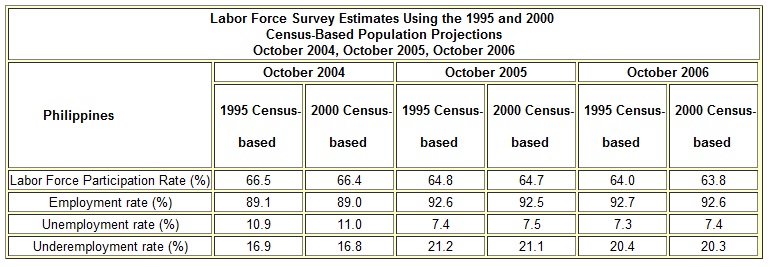
The employment rate in October 2007 was registered at 93.7 percent, higher than last year's rate of 92.6 percent.
Across regions, employment rate was highest in Cagayan Valley (97.7%). Other regions with relatively high employment rate were: Zamboanga Peninsula (97.1%), Autonomous Region in Muslim Mindanao (97.0%), Cordillera Administrative Region (96.9%), Eastern Visayas (96.8%) and MIMAROPA (96.3%). The National Capital Region (NCR) had the lowest at 89.4 percent.
There were 35.9 million persons in the labor force in October 2007 out of the estimated 56.9 million population 15 years old and over. This translates to a labor force participation rate of 63.2 percent, lower than last year's figure of 63.8 percent.
Of the estimated 35.9 million persons in the labor force, 93.7 percent or nine out of ten persons were employed. Almost half or 48.8 percent were in the services sector, almost the same percentage was recorded in October 2006 at 48.6 percent. More than one third (36.1%) were in the agriculture sector and the rest (15.1%) in the industry sector.
The laborers and unskilled workers constituted the largest occupation group with 32.0 percent of the total employed population. Farmers, forestry workers and fishermen registered the next largest group of workers, comprising 18.7 percent of the total employed persons.
Employed persons fall into any of these three categories: wage and salary workers, own account workers and unpaid family workers. Wage and salary workers are those who work for private establishments, government or government corporations and those who work with pay in own-family operated farm or business. More than half (51.1%) of the total employed persons in October 2007 were wage and salary workers mostly working for private establishments (37.7%). Those working for the government or government corporations accounted for 7.8 percent. More than one-third of the total employed population in October 2007 were own-account workers accounting for 36.5 percent of the total employed with self-employed workers registering the larger share at 32.3 percent.
Employed persons are classified as either full-time workers or part-time workers. Full-time workers are those who work for 40 hours or more while part-time workers, less than 40 hours. In October 2007, six out of ten employed persons were full-time workers, most of them working for 40 to 48 hours (41.9% of total employed) while part-time workers comprised 35.1 percent of the total employed.
Employed persons who want or desire additional hours of work are considered underemployed. The number of underemployed persons in October 2007 was estimated at 6.1 million, placing the underemployment rate at 18.1 percent, lower than last year's estimate of 20.4 percent. More than half (58.5%) of the underemployed were reported as visibly underemployed, or had been working for less than 40 hours a week. About 40.1 percent were underemployed working full-time. Underemployed persons working in the agriculture sector accounted for 48.6 percent of the total underemployed in October 2007. Those in the services sector accounted for 37.0 percent, while those in the industry sector, 14.4 percent.
The unemployment rate of 6.3 percent in October 2007 was lower than last year's estimate of 7.3 percent. Among the regions, only the National Capital Region (NCR) recorded a double-digit unemployment rate of 10.6 percent, which is also the highest among the regions.
The proportion of males to total unemployed (63.5%) in October 2007 is greater than that of females (36.5%). Unemployed persons who had attained high school level comprised 46.2 percent of the total unemployed, of which 33.2 percent were graduates. About 39.5 percent of the total unemployed had reached college level, and 13.7 percent attained elementary level.
(Sgd.) CARMELITA N. ERICTA
Administrator
Technical Notes
- Starting with the July 2003 round of the Labor Force Survey (LFS), the generation of the labor force and employment statistics adopted the 2003 Master Sample Design.
- Using this master sample design, the number of samples increased from 41,000 for LFS conducted from January 1997 to April 2003 to around 51,000 sample households for July 2003 and subsequent rounds of the LFS.
- The province of Basilan became part of Autonomous Region in Muslim Mindanao while Isabela City (Basilan) of Region IX, in accordance with Executive Order No.36.
- The 1992 four-digit code for Philippine Standard Occupational Classification (PSOC) and 1994 Philippine Standard Industry Classification (PSIC) were used in classifying the occupation and industry.
- Starting April 2005, the new unemployment definition was adopted per NSCB Resolution Number 15 dated October 20, 2004. As indicated in the said resolution, the unemployed include all persons who are 15 years and over as of their last birthday and are reported as: (1) without work and currently available for work and seeking work; or (2) without work and currently available for work but not seeking work for the following reasons:
1.) Tired/believed no work available
2.) Awaiting results of previous job application
3.) Temporary illness/disability
4.) Bad weather
5.) Waiting for rehire/job recall
- Starting with the January 2007 LFS round, the population projections based on the 2000 Census of Population was adopted to generate the labor force statistics. This is in compliance with NSCB Resolution No. 1 series of 2005 entitled "Adoption of the Methodology Used in Generating the 2000 Census of Population and Housing-Based National Population Projections". Estimates of employment indicators using data from previous LFS rounds and the 2000 Census-based population projections, and another set of estimates using the 1995 Census-based population projections, are presented below for comparison.

Source: Income and Employment Statistics Division
Household Statistics Department
National Statistics Office
Manila, Philippines
Page last revised: March 04, 2008
